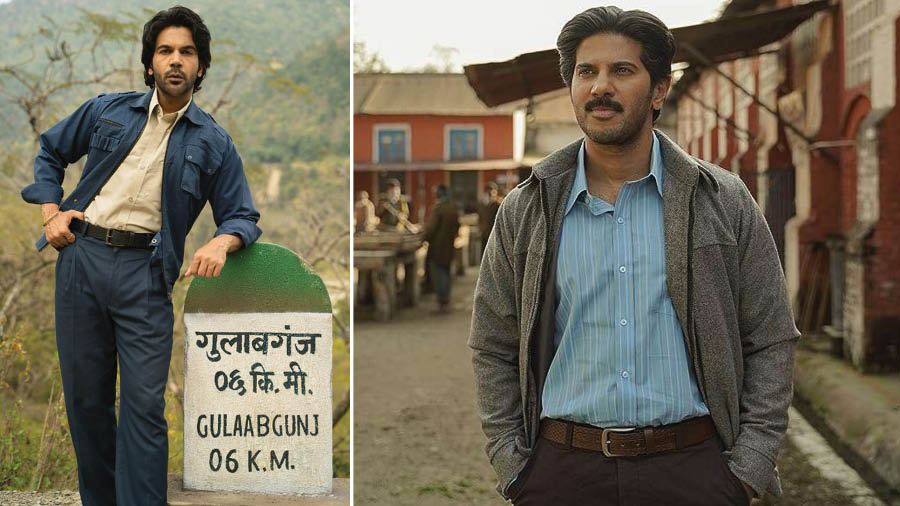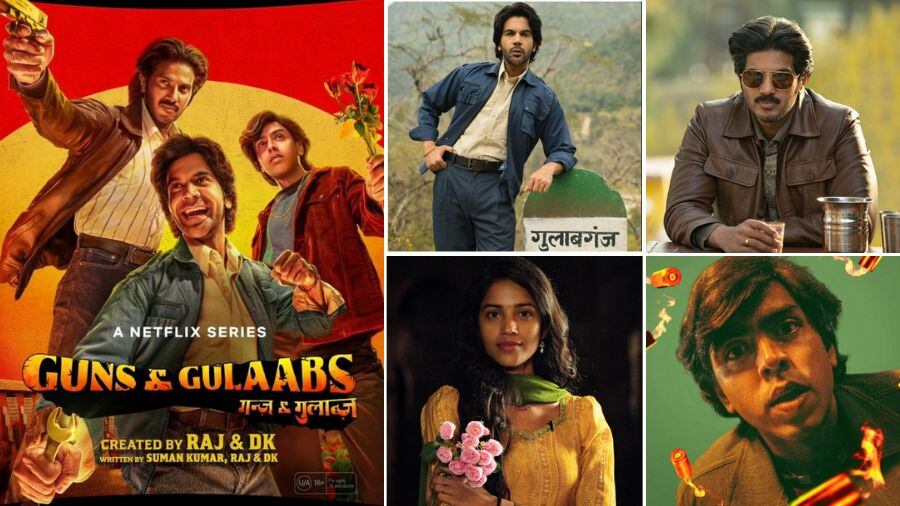Manmohan Desai, the Coen Brothers and Sriram Raghavan walked into a bar. Chairs went flying, forlorn lovers sang ditties in dimly lit corners, someone slipped on a banana peel and died while a Mexican standoff stood at the centre of it all. Raj and DK’s latest Netflix venture Guns and Gulaabs is the cocktail that was on the table at this bar.
A slight departure from the duo's latest high-octane and linear outings Family Man and Farzi, the first season of Guns and Gulaabs retains their signature quirk and focuses on flawed characters of all shapes, sorts and sizes. The seven-episode action-comedy is full of quirk, where every character has an ulterior motive and is itching to carve out their own place in the jungle of madness.
My Kolkata dives into the labyrinth of non-linear vignettes, tributes, and pure nostalgia.
The crux (sans spoilers)

Rajkummar Rao as Tipu and (right) Dulquer Salman as Arjun walk a fine line between hero and villain
Set in Gulaabgunj — a fictional town of opium farmers and cartels — in the early 1990s, the story centres around an illegal opium deal. At the centre of this multidimensional plot are the father-son semi-gangster duo of the Ganchi family (Satish Kaushik and Gourav Adarsh); Tipu (Rajkummar Rao), a simpleton mechanic with a crazy side; a freelance assassin with seven lives names Chaar-cut Atmaram (Gulshan Devaiah); and the town’s newest city import and narcotics officer Arjun Verma (Dulquer Salmaan). Plus, there is Rajatava Dutta as Sukanto, the dealer from Kalkatta. Things go haywire as what begins as a game of chess turns into a no-holds-barred paintball over the course of eight episodes (the last one is a double feature). In the midst of the mayhem, there is a brewing love story, some teenage pranks, an alleged affair and much more.
It’s in the little things
What completes the nostalgia trip that is Guns and Gulaabs is the little details. The quintessential pre-millenium charm of a small, northern Indian town with open plains, rivers and creeks, a maze-like network of lanes and houses and a local dhaba where temporary truce prevails. It is also in this eatery, where a lot of the testosterone-fuelled action and much of the brooding and thinking occurs in the midst of clinks of Campa Cola and Gold Spot bottles.
Single-screen cinemas, phone booths for STD, where you kept an eye out for the 1-min mark, noisy mopeds, snazzy Yamaha RX 100 and Yezdi bikes, handwritten letters, bulbous and pink perfume bottles, Game Boy consoles, lending libraries — it is a collection of small details, often thrust into the forefront, that form the nostalgia leitmotif giving Guns and Gulaabs its charm.
From Tipu’s baggy ragged sweater, young boys in trousers and local tailor-made shirts, to the stylish and rich Jugnu ‘Chotu’ Ganchi’s (Adarsh Gourav) dressed in turtlenecks, denim jackets and colourful pants reflects the daily realities and economies of the common man of the decade. Arjun’s jeans-leather jacket look with a middle-parted hairstyle and sideburns that screamed ‘cop!’, is reminiscent of Amitabh Bachchan and Vinod Khanna's heyday, and a tip to his big-city roots, a trope reflected equally well in his daughter’s choice of language of communication — English, and dressing style — jeans and top.
Beginning with the end
It’s not often we bat our eye towards the end credits if we don't await a Marvel-esque post-credits shock or a dance number playing parallel. While the opening intro sequence of the show is a delightful pop-art play of colours and negative silhouettes, we would suggest you to take some time and watch the end-credits for the nostalgia and some Wes Anderson-like feels.
The primary credits appear on a series of flickering 4:3 aspect frames with the names appearing on ’90s nostalgia chips — boxy televisions sets, sewing machines, Campa Cola adverts, envelopes and postage stamps, perfume bottles, packed lozenges, jellies and fryums, cassettes, geometry boxes, and cigarette packs. It is all set to the tune of Shailendra Singh’s Hoga tumse pyara kaun from 1981 Rishi Kapoor-starrer Zamaane Ko Dikhana Hai. It’s the perfect antacid to every episode with its share of the obnoxious and the obtuse.
Easter eggs and hat-tips
For any pop-culture enthusiast, the references peppered through the show are especially delightful. Apart from the name itself, clearly inspired by famed American hard rock band Guns N’ Roses, and a poster font that will instantly bring to mind the likes of Sholay, Deewar, and the Indiana Jones movies, each episode name is also a hat-tip to famous classics. Barring the first and the sixth, all episodes have been named after a retro bouquet of films and songs of yore. There’s a Kumar Sanu classic, a Bryan Adams ballad, a television game show that was a big ‘deal’ back in the ’90s, a Mithun Chakraborty action masala flick, and (obviously) a Bappi Lahiri number. Raj and DK carefully manage to weave in slight references to Farzi and Family Man as well, using those exact phrases in the flow of conversations within the show.
The duo have also managed to capture everything fun — and cringe (in hindsight) — about the Bollywood-inspired high fashion of the ’90s and the common Indian folk’s ultimate obsession with the stars of Hindi cinema.
Cold-blooded assassin Atmaram’s jeans-and-leather looks and signature mullet takes one back to the image of Sanjay Dutt in Khalnayak, with a sprinkle of Mithun Chakraborty. Through the series, you are reacquainted with small-town India’s hero worship of Bollywood and the absolute excitement with the few international movies and cult classics that made it to theatres outside or urban settings in that era.
There are posters and cut-outs of NTR (Sr), a young Aamir Khan, Zeenat Aman and others which can be seen stuck on walls throughout Gulaabgunj. Tipu and his best friend’s excitement to catch a show of The 36th Chamber of Shaolin or “Shaolin ka chhattiswa kamra”, and mentions of the thriller-era authors like Desmond Bagley and Alistair McClean are sure to pull a giggle as you look back on visits to the cinema — single screen — and furtively borrowing books with objectionable covers.
It’s not just Indian cinema that gets a hat tip in the series. Ganguram (Tanishq Chaudhary), an academically slow but street-smart, waggish school going kid and part of the troika that forms a central cog to the story is infatuated with his teacher, Chandralekha (TJ Bhanu), who incidentally is also the woman of Tipu’s dreams. In Gangu’s musing and antics, one can’t help but remember Wes Anderson's 1998 cult classic, Rushmore. The spanner-in-the-eye and blood spurts brand of violence on exhibition throughout the series also makes for a fun mishmash of the Coens style, perhaps with a strain of Guy Ritchie.
Retro tunes and fond memories
The recent Netflix retro fad has been refreshing, and with Aman Pant’s music, Guns and Gulaabs fits right in. Picture this: four people — two school-going teenagers and two happy-go-lucky grown ups sit in the middle of a field listening to Bryan Adams’ iconic rock ballad Everything I Do...I Do It for You on a cassette player boombox, while one of them composes a love letter. Can it get any more retro!
The episodes have been planted with songs that play to the mood perfectly. In his introductory scene, Arjun is seen tossing away a cassette of good ol’ Jhankar Beats, frustrated at the needless dilution and pulse — something a number of people would relate to.
The entire series rides high on the reigning sounds of the late ’80s and early ’90s with Shailendra Singh’s Hoga Tumse Pyaara Kaun, RD Burman classic Yeh Vaada Raha on one side and Foreigner’s Waiting for a Girl Like You on the other. To top it all, Aman Pant brings back the voice that defined the decade in Hindi cinema — Kumar Sanu — for a beautiful guest track Do Raazi and another retro original Bharam. The moods of Gulaabgunj and its inhabitants and neighbours are portrayed through the music.
In the end, the Raj & Dk production doesn’t quite pack the same punch of the same kind of rush that Farzi or Family Man gave you. The pace and the comedy fall just short of their peak, with some of the concluding ‘twists’ being quite predictable if you look closely through the series. However, the director duo have pulled no punches when giving you a bioscope of every nostalgic trope, and they have done it well. Within the borders of Gulaabgunj and its neighbouring Sherpur is a world beautifully stuck in time. Perhaps, the pull of the series is that everything about the town is chaotic, but in cinemascope, life is lived king-size in Gulaabgunj.
